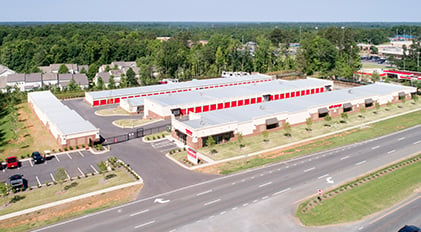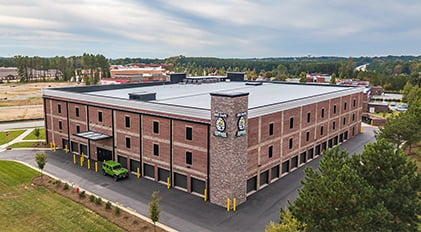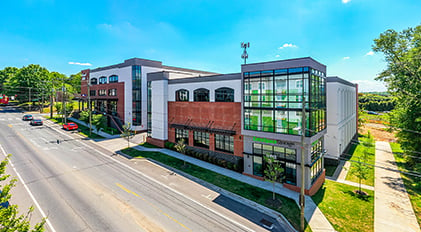Intro
The self-storage industry is booming and with good reason! These facilities typically have low operating costs and low defaults, paired with high levels of demand — even during periods of economic uncertainty when they often outperform most other commercial investments. With many Americans downsizing their homes & offices, and housing markets continuing to grow and expand, there’s no wonder why savvy investors have turned their attention to the self-storage market.
Unfortunately, without the right foundation in place, your project can become overwhelming and quickly spiral out of control. This is especially true if you’re taking a traditional approach to the building process, where even the smallest missteps can push your timeline out by months and drive your project costs unnecessarily higher. Not to mention, the increased stress that stems from managing multiple teams governed by separate contracts and no united vision can be as frustrating as it is costly and time-consuming.
That’s where we come in.
Whether you’re looking for a new investment opportunity or expanding your existing self-storage business, we’ve got you covered! With more than 50 years of experience in the commercial real estate space, we created this guide to illustrate how the design-build process can help streamline operations, reduce costs, and bring your project to life even faster.
An overview of the design-build process
The success of your self-storage project depends on five critical steps. We’ll cover these in greater detail in later sections, but let’s first look at the process as a whole:
- Step 1: Determining market demand
- Step 2: Calculating your budget
- Step 3: Site Selection
- Step 4: Design and Permitting
- Step 5: Constructing your self-storage facility
But, before you can spring into action, you’ll need to make the most critical decision of all: selecting which approach you’ll take to the building process.
Two approaches to building. Two dramatically different results.
There are two commonly used building methods to consider: 1) the traditional design-bid-build method, also known as “plan-and-spec,” and 2) design-build — Metrolina’s proven approach to self-storage construction.
Here are a few noteworthy differences you should consider when making your selection.
Plan-and-spec: the traditional approach to building
In plan-and-spec, the owner first hires a design team (architect, civil, mechanical, electrical, plumbing, structural engineer, etc.) and works with that group to develop construction documents & plans. Ultimately, the owner holds a separate contract for each of the designers as well as a General Contractor (who isn’t introduced until after the design is complete). This arrangement can create silos, with each key team member working on their own island without a shared goal. This often creates conflict between teams.
Next, the owner independently solicits bids from general contractors, choosing a contractor and price based solely on what is shown on the drawings. If pricing comes back greater than anticipated, significant time and money are required to get the project back on track. More importantly, if the drawings do not properly convey the owner’s goals and project needs, additional costs can show up later in the project, putting the overall budget at risk.
Of course, a delayed launch isn’t the only risk one encounters with this model. In a plan-and-spec scenario, by not involving the Contractor sooner, owners also open themselves to additional risks, like paying for a full set of drawings that can’t be built for their budget.
Design-build: your all-in-one solution for building self-storages
Design-build is a project delivery method in which a single team works under a single contract to provide turnkey due diligence, design, and construction services. There’s one flow of work from initial concept through completion. This method has become very popular in recent years, as it’s proven to shorten self-storage build timelines, reduce risk, lower overall costs, and remove many burdens owners and investors might face.
This holistic approach helps drive synergy, as many project steps can happen at the same time. For example, front-end construction functions like schedule development, shop drawings, material purchasing, and manpower preparation can take place while the final design documents & permitting are being completed.
If you plan to take the design-build path, it’s best to engage the contractor as early in the process as you can. Then, the contractor will be able to develop early & accurate project budgets and recommend design choices that can decrease the overall budget.
Let’s take a closer look at how the design-build approach can help improve each of the five critical steps needed to achieve a successful build.

Your guide to building self-storage
Discover how you can help lower your costs, improve efficiencies, and achieve a faster timeline by adopting a design-build approach.
Step 1: Determine the market demand
Without Metrolina Builders
When determining market demand for your self-storage facility, the first step is to find, hire, and manage a feasibility consultant. Otherwise, you’ll be left to conduct your own demand analysis and will be severely limited by the types of tools at your disposal.
That means you might have to rely on resources like Google Maps to determine competitor locations and approximate the square footage of their facilities. Alternatively, you can embark on a more complicated approach by working with county tax appraisers, tracking down parcel ID numbers, and researching any potential updates that might not be reflected in their records.
Once you’ve identified the size and locations of your competitors, you’ll need to determine how much your competitors are charging for rent. Then, you need to estimate occupancy rates at each of your competitors – this can include a tremendous amount of guesswork. As you might imagine, the risks are significant.
With Metrolina Builders
When you hire us, you get a lot more than a builder. You get a seasoned partner who’s by your side from the very beginning. We remove the guesswork from hiring a feasibility consultant because our partners have been fully vetted and battle-tested. Together, we’ve constructed more than 5 million square feet of commercial real estate for more than 1,000 happy clients.
Of course, we’ll also take on the burden of ensuring that you have the most accurate market data available — because all feasibility studies were not created equal and can lead to vastly different conclusions. This includes, in part:
- Identifying competitor locations & occupancy
- Calculating the square footage of competitor locations
- Determining occupancy levels of competitive properties
- Conducting due diligence
- and more!

Step 2: Calculating your budget
Without Metrolina Builders
The next step of the process is to prepare your budget and identify the costs of building a self-storage facility. This is one of the most crucial elements of any real estate project, so even the most seasoned self-storage pro could use professional assistance. Often an owner relies upon their architect for historical cost information. However, architects lack the real-time knowledge of market costs to provide accurate construction budgets.
Generally speaking, you can expect the land cost to equal around 25-30 percent of your total development costs — but that’s only part of the equation. You’ll also need to factor in the cost of building cost, site development, water & sewer taps, permits, and many additional expenses you might not expect. Additionally, you’ll need to hire a full team of professionals and manage each of their contracts and individual budgets separately, hoping that each is designing a building that can be built cost-effectively and within your budget. This can quickly turn into a full-time job.
With Metrolina Builders
We handle the most time-intensive, stressful, and risky elements of the design & building process for you. You only have to worry about managing one relationship: the one you hold with us, your design-builders.
Our holistic and integrated approach allows us to drive down the high costs associated with siloing, operational inefficiencies, and duplicative work. In fact, you can even understand the true cost of your project before paying substantially for design services. With a site plan, survey, and soils report, the design-builder will be able to complete conceptual design in-house and provide a cost estimate much earlier in the process.
This helps the owner alleviate their hard-cost risk. Experienced developers can conduct due diligence, site planning, and the solicitation of design-build pricing into their land-option period, giving them a transparent picture of the total project costs before giving earnest money.
In design-build, the client is only at risk for extra costs if they decide to expand the project scope.
Step 3: Site Selection
Without Metrolina Builders
Here’s where things can get even more complicated…and risky. Before looking for suitable build sites, you must visit your local jurisdiction’s zoning department to find all zoning designations for self-storage or the likelihood of being able to rezone a site for self-storage.
Once you’ve identified proper zoning classifications, it’s time to review potential sites. If going the traditional route, you’ll need to hire a local commercial realtor and a contractor who specializes in self-storage. The contractor can help determine what the cost would be to develop the different sites so you can make a more informed decision.
Additionally, you’ll also need to identify traffic patterns in the area. After all, nearly 85% of self-storage customers found their location by traveling past it. And 75% of renters live or work less than two miles from the facility.
With Metrolina Builders
We believe a successful project hinges on securing the right piece of real estate. Our clients regularly engage us early in the process, so we can help them select the ideal property.
We help calculate their space needs to determine the optimal building size. From there, we analyze various sites to determine the development costs and review geotechnical surveys to better understand the subsurface conditions.
This frequently includes organizing, managing, and executing the following tasks on behalf of our clients:
- Site Analysis / Evaluation
- Due Diligence
- Geotechnical and Survey
- Programming
- Master Planning
- Conceptual Design
- Budget Development
- Rezoning
Step 4: Design & Permitting
Without Metrolina Builders
This can be one of the most frustrating elements for owners and investors — as well as the most costly. If your architect, engineer, and contractors aren’t fully aligned, many disastrous scenarios can throw the entire success of your project in jeopardy.
For example, you could receive incredible designs from your architect, but they fail to utilize the most cost-effective materials or building systems and can’t be built for your budget. These types of risks could significantly increase your costs, delay your opening by months, or even worse, you might have to go back to the drawing board entirely.
With Metrolina Builders
One of the best benefits of working with Metrolina Builders is that we are your one-stop shop for project management and execution. Because we are involved early and often in the process, we can help ensure that everyone is on the same page.
We eliminate the surprises and headaches that occur from managing a disjointed team. During the pre-construction phase, we work overtime to identify your desired outcomes, assess any risks you might face, and develop proactive plans that will serve as the basis for your project.
Early integration of Metrolina’s extensive experience is how we can generate the most value for our clients. Components of our pre-construction services include:
- Design / Engineering Coordination
- Building Systems Evaluation
- Constructability Review / Conflict Resolution
- Logistics Planning
- Subcontractor / Vendor Integration
- Value Engineering
- Preliminary Budgets/Estimates
- Preliminary Scheduling
- Subcontractor Solicitation / Evaluation
- Estimating
- Permit Coordination
Step 5: Building your self-storage facility
Without Metrolina Builders
The construction phase is where the rubber meets the road. All the careful and thorough planning now moves to execution. Unfortunately, if you’re using a traditional building approach like build-and-spec, this may be the first time you identify costly mistakes in earlier steps.
If this occurs, you’ll find yourself scrambling to get your project back on track and potentially having to scale back to reduce the budget to an acceptable level.
In addition to being time-consuming and costly, this can be an incredibly stressful and lengthy process to remediate on your own.
With Metrolina Builders
Metrolina’s talented team of construction professionals, guided by half a century of experience with complex projects spanning multiple market segments, provides the project management and field supervision knowledge necessary to deliver a successful project — on time and within budget.
Our Construction phase services can include:
- Site Work
- Core and Shell
- Tenant Improvements
- Scheduling
- Project Management
- Cost Controls
- Subcontractor Management
- Quality Control
- Safety Compliance
- Submittal Management
- Inspections Management
- Project Closeout
Ready to get started? Contact us today.

Your guide to building self-storage
Discover how you can help lower your costs, improve efficiencies, and achieve a faster timeline by adopting a design-build approach.


